18 Nov The Master Builder of New Delhi
Sir Edwin Lutyens defining legacy still surrounds us today
It may seem strange to mention New Delhi when writing about St Paul’s Cathedral, but there is a connection. For, buried under the famous London landmark’s soaring domes are the ashes of Sir Edwin Lutyens, the English architect who built New Delhi and designed it from scratch.
Delhites know “Lutyens Delhi” for its white ministerial bungalows and wide tree-lined streets in which India’s rich and powerful reside. But much less is known about the man who conceived and built it. Edwin Lutyens spent twenty years of his life creating India’s capital city, literally clothed in Delhi’s dust, and during these years he developed an intimate love-hate relationship with the country. In fact, Lutyens attitude towards India had so completely permeated his personal life that it affected even his closest relationships, including with his wife and daughters. I had seen and admired many of Lutyens magnificent creations, and when, while researching his life, I found that Lutyens was buried in St Paul’s Cathedral, I decided to call on his final resting place.
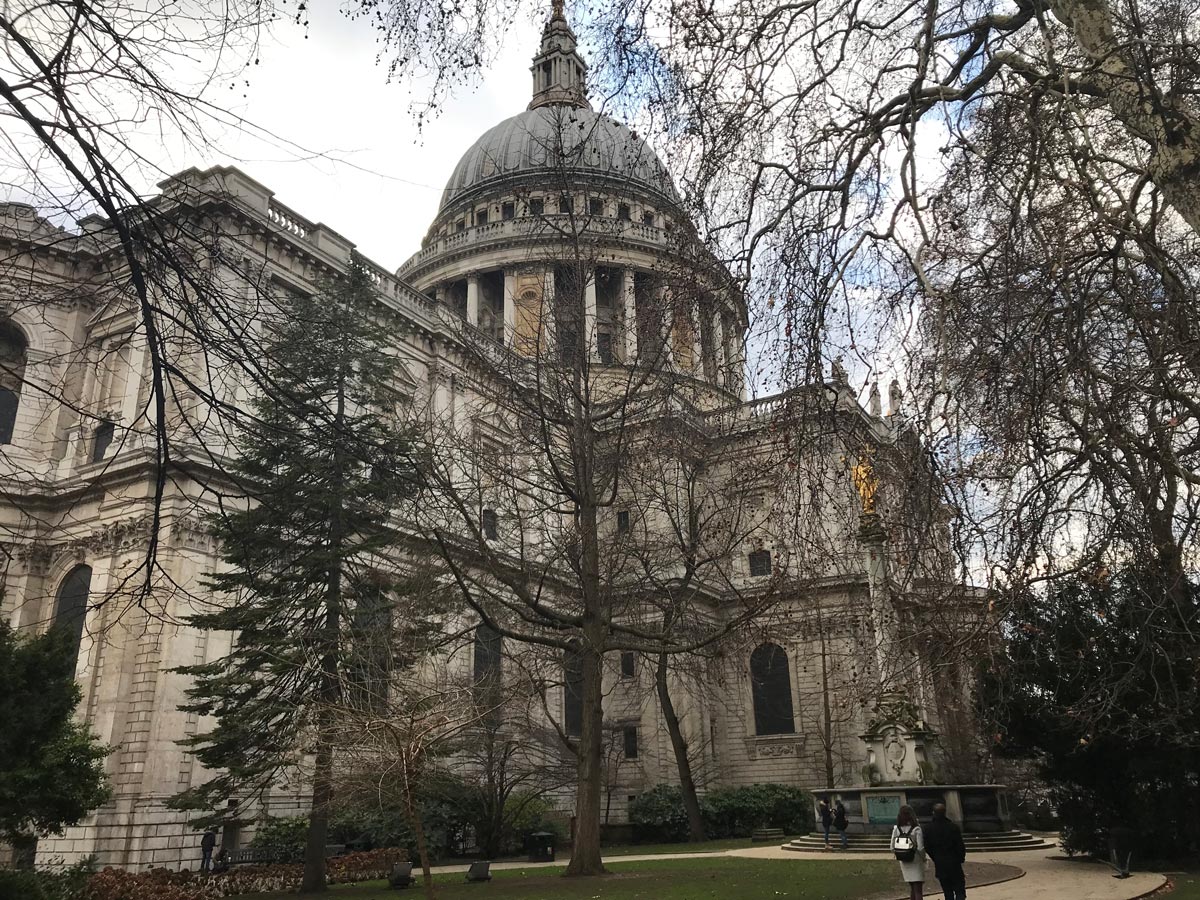 St Paul’s Cathedral dome, which has dominated the London skyline for three hundred years, framed through winter’s leafless trees
St Paul’s Cathedral dome, which has dominated the London skyline for three hundred years, framed through winter’s leafless trees
When I visited St Paul’s Cathedral, with its huge brooding dome framed against London’s grey winter sky, I didn’t really know what to expect. I joined the ticket queue, huddled together in thick jackets as a cold, sharp wind whipped our faces.
Pigeons swooped around us, feathers puffed against the cold, pecking optimistically at crumbs on the ground. Most visitors were here to see the celebrated graves of Admiral Lord Nelson or Arthur Wellesley or Christopher Wren who built St Paul’s. As I bought my ticket and entered the cathedrals’ revolving doors, I wondered whether I would even be able to find Edwin Lutyens in what is the largest crypt in Europe…
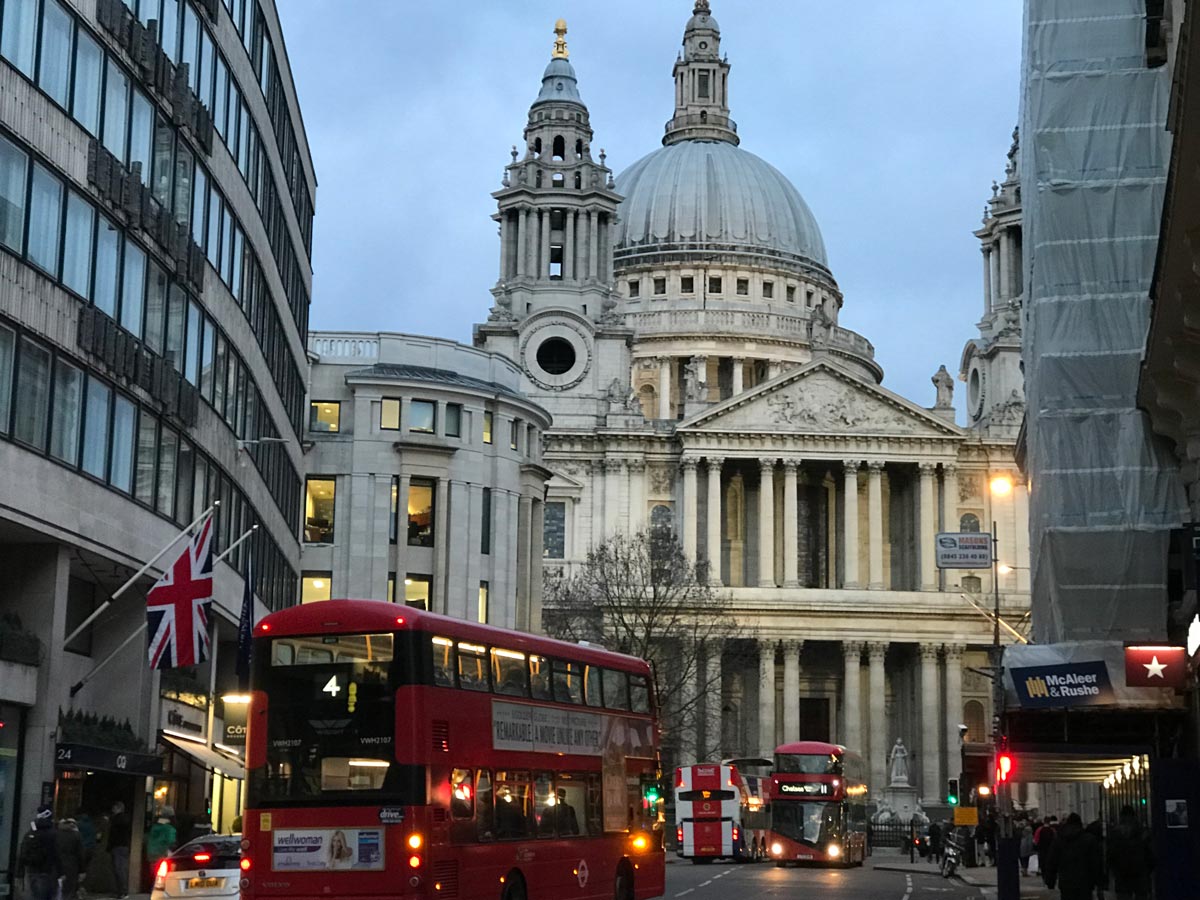 Quintessentially London ; The builder of New Delhi is buried in one of London’s most famous landmarks
Quintessentially London ; The builder of New Delhi is buried in one of London’s most famous landmarks
I approached the “Friends of St Pauls”, a pleasant team of volunteers behind a wooden desk. They worked here as helpers for their love of history and architecture, they told me. Would they know where Edwin Lutyens was buried? This was an unusual request. A polite man in a suit, and a bunch of ladies of a certain age pulled out various reference books. They needed their reading glasses, which was passed around amid much turning of pages. Caroline introduced herself to me, saying she’ll join me in the “quest for Lutyens”. She knew who he was, and had been to India and seen his glorious buildings. She was as interested in locating him as I was.
Lutyens is buried in the crypt of St Paul’s Cathedral, in a section called the OBE chapel. This is truly a unique space, filled with the memorials and graves of both the ordinary dead as well as some of England’s greatest heroes. We descended the ancient stone staircase to enter the crypt, stepping around age-old graves with the remains of entire families; sons, daughters and grand children lying side by side, the carved letterings worn with age and barely readable. “Lamented wives”, who “survived her husband scarcely four months but long enough to feel the emptiness of life without him”.
Throughout were the graves of the “servants of the cathedral”; vicars, rectors, organists, choir masters, canons, treasurers…and among them also the tombs of the cathedral’s most famous inhabitants; the Duke of Wellington, the Admiral Lord Nelson, the poignant black-slab grave of Christopher Wren who built this Cathedral, tucked in to a corner with a simple statement “reader, if you seek his monument, look around you”.
We found Edwin Lutyens, with a plaque on the wall reading “here are laid the ashes of Sir Edward Lansdeer Lutyens. Architect. President of the Royal Academy of Arts”. Below the plaque was a tile inscribed with the initials “E.L.L.” under which his ashes were buried. Lutyens was cremated at the Golders Green crematorium before his ashes were bought here. Under this small time-worn stone lay the man who built the stunning edifices of New Delhi.
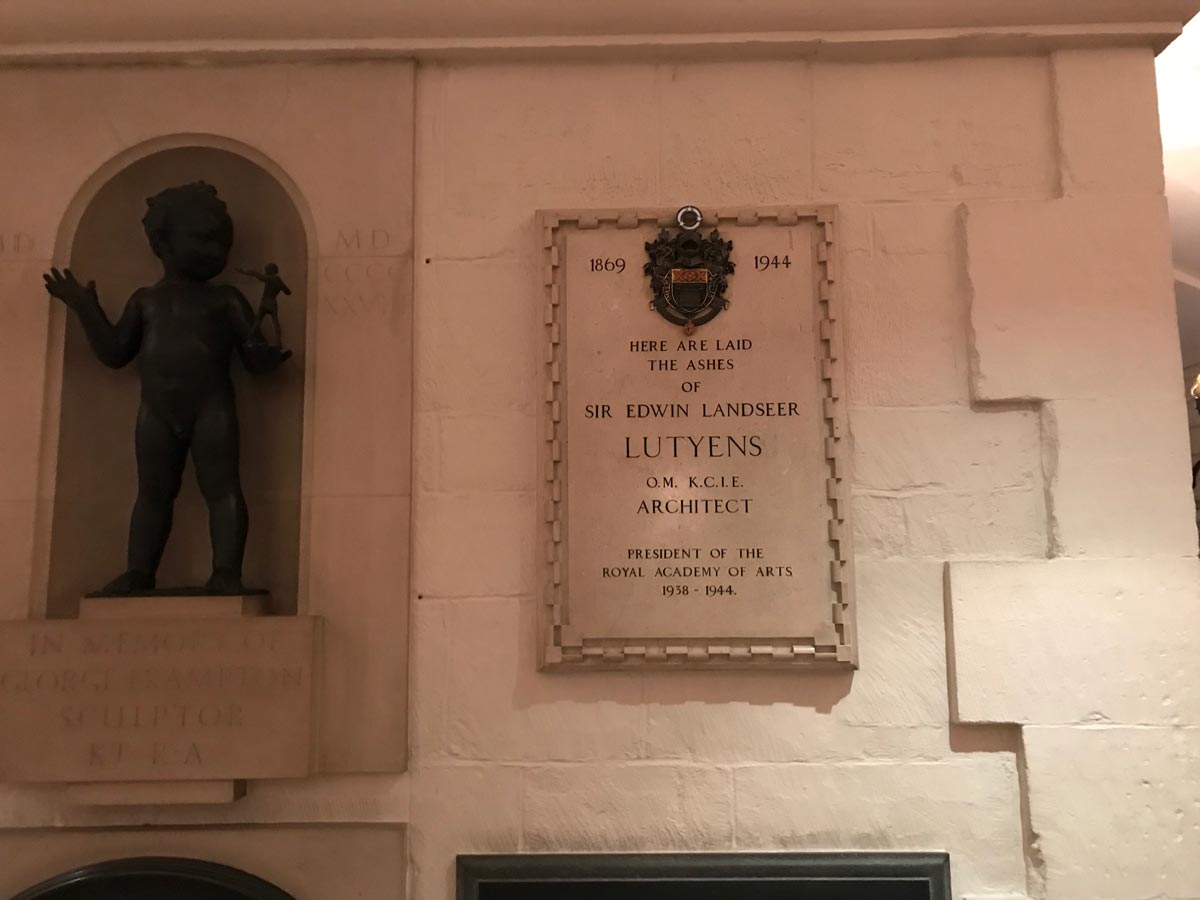 The Burial Place of Sir Edwin Lutyens, in the crypt of St Paul’s Cathedral
The Burial Place of Sir Edwin Lutyens, in the crypt of St Paul’s Cathedral
Edwin Lutyens (1869-1944) was born in London to a large family, being the tenth of thirteen children. He was a sickly child, considered too delicate to be sent to school and so was mainly self-taught, a fact that he believes left him “shy of committees and officials but entirely original in thought”. By the time he was sixteen, Lutyens was certain he wanted to be an architect and after studying at London’s South Kensington School of Art he had started his own architectural practice. His reputation as an architect grew quickly as he designed everything from country houses to castles to churches, including the wonderfully under-stated Cenotaph in London. Soon, Lutyens was considered one of England’s foremost architects.
In 1912, Lutyens was invited to be part of a three-member Planning Commission, tasked with building New Delhi as the new seat of government in India, replacing Calcutta. The plan was to construct a new Indian capital that would reflect the grandeur and supremacy of colonial rule in India, rivaling the other great imperial capitals like Washington and Paris. Lutyens left England for his initial voyage to India on March 28th 1912, just a day before his forty-third birthday.
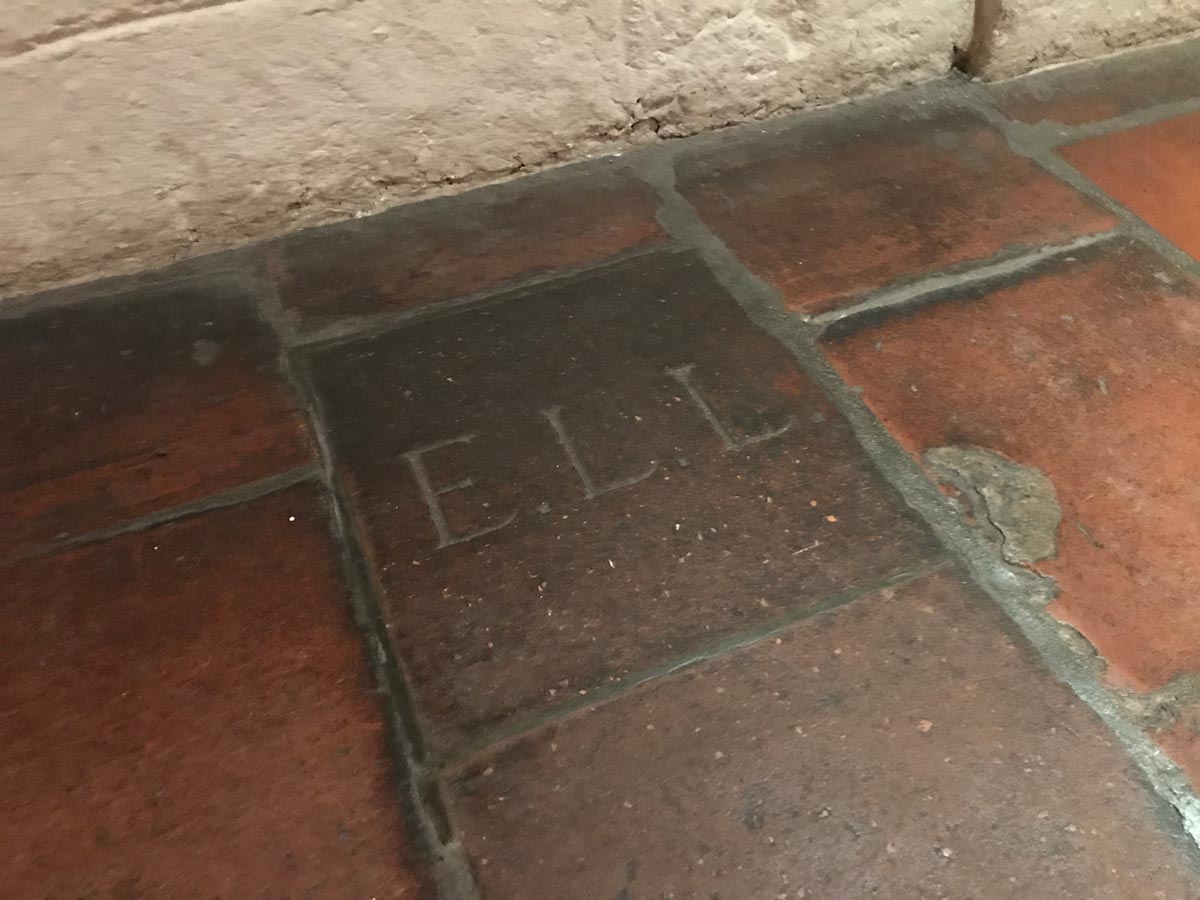 Under this Tile lies interred the ashes of the man who built New Delhi
Under this Tile lies interred the ashes of the man who built New Delhi
Edwins’ daughter, Mary Lutyens, provides a wonderful description of her fathers arrival in Bombay… “ dozens of native bearers were waiting to be engaged on the quay at Bombay, as they always were on those days that a ship came in. Father, slow off the mark, found that all the presentable looking ones had been snapped up by the other passengers; the only one left for him was “an old scallywag dressed in an uncouth dhoti”. This was Pershotum who was to serve him with loyal devotion for eighteen years. I came to know Pershotum well when I went to Delhi in the twenties. Always smiling his toothless smile he was at the same time wonderfully efficient, arranging dinner parties and protecting Father from all household anxieties. He hero-worshipped Father, loving his jokes even when he could not understand them” *
The Planning Commission had stayed at the genteel Maiden Hotel (now Oberoi Maiden) and roamed the area on elephants, sweltering in waistcoats and stiff collars and ties “in temperatures of 104 degrees” seeking a suitable spot for the new capital…”of twenty five square miles at not too high a cost, close to the existing city, with a good water supply, fertile soil and room for expansion while in no way interfering with the sacred ruins and tombs of the half buried former cities.” Eventually, Raisina Hill was chosen as the site.
For the next seventeen years, Lutyens devoted himself to the project of creating India’s new capital. During this time, his rapport with India and Indians hit many highs and lows, his marriage got strained to the point of breaking, his relationship with co-architect Sir Herbert Baker (yes, there were two of them responsible for building New Delhi, not Lutyens alone) went through unseemly quarrels and ego clashes, and his dealings with successive Viceroys were often bitter and fraught. It was not a stroll in the park for Lutyens, as India exposed his many strengths and frailties.
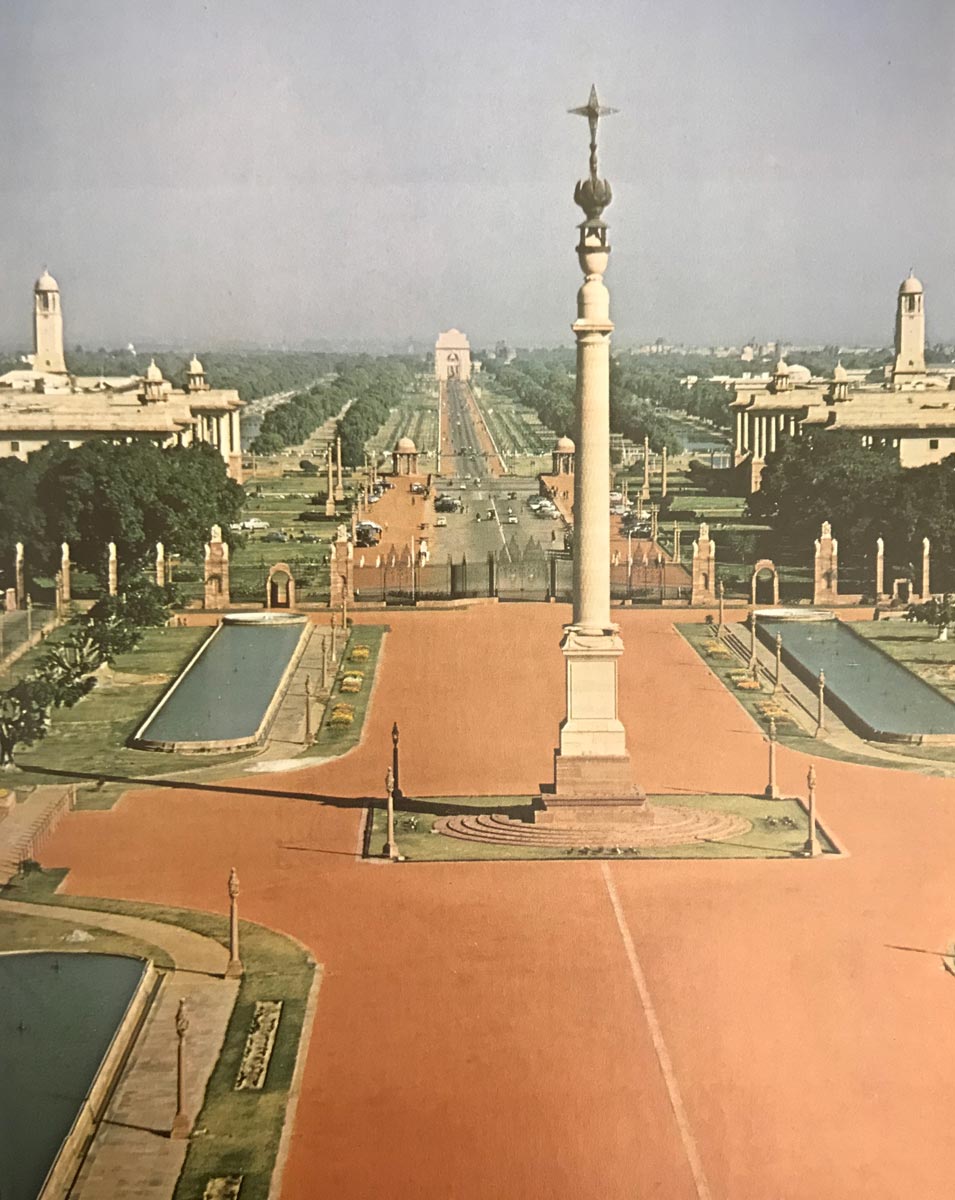 Lutyens majestic New Delhi creations; Kingsway and India Gate as seen from Viceroy House on Raisina Hill
Lutyens majestic New Delhi creations; Kingsway and India Gate as seen from Viceroy House on Raisina Hill
Lutyens’ passionate personality included an innate chauvinism and a sharp wit. Though his architectural designs eventually blended the east and the west, in what is now known as the Delhi Order, Lutyens’ early views on Indian architecture were anything but complimentary. Sample this, a note he wrote to his colleague Baker, as two “recipes” for Indian styles :
Hindu : Set square stones and build childwise, but, before you erect, carve every stone differently and independently, with lace patterns and terrifying shapes. On top, over tra-beated pendentives, set – an onion.
Mogul : Build a vasty mass of rough concrete, elephant-wise, on a very simple rectangular-cum-octagon plan, dome in anyhow, cutting off square. Overlay with a veneer of stone patterns, like laying a vertical tile floor, and get Italians to help you. Inlay jewels and cornelians if you can afford it and rob someone if you can’t. Then on top of the mass put three turnips in concrete and overlay with stone or marble as before. Be very careful not to bond anything in, and don’t care a damn if it does all come to pieces.”***
Ultimately, what we got is the New Delhi we know. Inaugurated in 1931 by then-Viceroy Lord Irwin, New Delhi is today the capital city of the world’s biggest democracy and the central pole around which the rest of India revolves. Lutyens has left us a legacy of magnificent buildings and sweeping vistas; the Viceroy’s Palace (Rashtrapati Bhawan), the central axis of Kingsway (Rajpath), the poignant India Gate. And, to this day “Lutyens Delhi” retains its slightly distant air of distinguished government offices, impressive boulevards and tree-lined streets.
The Quarrel for Raisina Hill
The creation of Delhi was not Lutyens’ work alone. There were two architects involved. The other was Herbert Baker, an equally distinguished English architect. While Lutyens designed the Viceroy’s Palace, the central axis of Kingsway (now Rajpath) and India Gate, it was Baker who designed the circular Parliament House and the twin secretariat buildings – North Block and South Block (and also – as a piece of trivia for cricket lovers – the Grandstands at Lords Cricket Ground and “Old Father Time”, its iconic weather vane).
Lutyens and Baker had constant running battles, fighting over just about everything. But, their biggest quarrel centered around the gradient of Raisina Hill. For Lutyens, the very heart of his vision for New Delhi was for the Viceroy Palace to sit in solitary majesty atop Raisina Hill being seen from every part of the city. The Secretariat buildings that flank the Palace – the North Block and South Block, which Baker was designing – would be at a lower level in order not to disrupt its “exclusive dominance”. For this, the gradient of Kingsway as it climbed to the crest of Raisina Hill was to be adjusted in such a way as to have a continuous view of the Viceroy Palace as one ascended.
But for Baker, this was an unnecessary flourish making the budget unachievable. In his view, the Palace should not “conspicuously crown the hill” but instead the Secretariat buildings be placed on the same platform symbolizing that the administrative and executive powers form “one composition expressing unity in the instrument of Government”. It was Baker’s idea that won, and the effects of that decision are evident to this day. Approaching the Viceroy Palace from the processional route of Kingsway, the visitor begins to lose sight of the Palace till only the dome is visible above the brow of the hill. Finally, only upon crossing the hill’s crest, does the Palace in all its glory become visible again.
The face of New Delhi could well have been different had harmony prevailed between its two master architects. As Lutyens sarcastically put it “I have met my Bakerloo”.
A sad story of a collapsing marriage
Lutyens had married Emily Lytton, the daughter of Lord Lytton, a former Viceroy of India, in 1897 when he was twenty-eight and she a young twenty-three. Though as a couple they had five children together, the marriage was never a success. There wasn’t very much in common between the two, but what drove a final wedge between them was Emily’s increasing closeness to eastern spirituality, her being influenced by the teachings of the Indian guru Jiddu Krishnamurthi and becoming his disciple. For Lutyens, who had such a dismissive attitude towards India, this was beyond what he could bear.
The slow disintegration of their relationship is traced by their daughter Mary Lutyens in the emotional letters they wrote each other. More than four thousand letters between Edwin and Emily Lutyens survive, and the pain felt by both is palpable… “While Ned was still in Delhi, Emily had written to him trying to explain her feelings…how she and Krishna had gradually come to feel for each other as mother and son. “I know your feelings for Indians makes this hard for you to understand….but I have no such feelings, and they seem to me like my own boys”. Ned replied ; “ I loved your dear letter and know how you feel and what you feel. And you must know too what I feel and I feel some things very strongly indeed. The color question is one and there is no compromise. I want darling for your to know this and realize it. There is one limit beyond which I should prefer death….don’t darling go so far as to blast our happiness”**
They ended up spending separate, restless lives. But, they never divorced.
Beyond Lutyens ….exploring the wonderful St Paul’s
Having offered your salaams to Lutyens, you would do well to explore the rest of this magnificent building. St Paul’s Cathedral is one of London’s oldest landmarks and a key player in England’s history. Many important events have happened here; the funerals of Lord Nelson, Winston Churchill and Margaret Thatcher. The 1981 wedding of Princess Diana and Prince Charles.
Start by standing under the great dome that defines the Cathedral. I took a seat on one of the wooden pews underneath the dome to catch my first exhilarating glimpse of its beauty and vastness, looking up at the soaring mass two hundred feet above my head. Far above me, visitors walked along the whispering gallery that rings the dome on the inside, the flashes from their cameras like sparkling pin-pricks as they casually disobeyed the many signs for no photographs.
Nearly every nook and cranny of the cathedral floor is crammed with religious art, statues and monuments. This includes the memorial to Arthur Wellesley, another famous resident of St Paul’s Cathedral who has a strong connect with India. Arthur Wellesley was a two-time prime minister of England, defeater of Napoleon at the Battle of Waterloo, and one of England’s foremost national heroes. He too earned his military spurs in the dusty battlefields of India, leading the East India Company to a pivotal victory over Tipu Sultan at the Battle of Seringapatnam and raising the toast “Ladies and Gentleman, I drink to the corpse of India” when news of Tipu’s death was bought to him. And he had pushed back the Maratha ascent, with victory at the Battle of Assaye where he had two of his horses shot from under him and yet mounted a third to lead his troops to victory. He would later comment that Assaye and not Waterloo was the best battle he ever fought.
If you are up to it, try climbing the 528 steps to the top of the dome. That’s a thousand steps both ways, but with it a chance to see parts of St Paul’s Cathedral that many visitors do not see. I joined a line of hardy people making their way up. The stairs start wide and easy to climb but become increasingly narrow and steep as one ascends the more tapered sections of the dome.
The climb was divided in to three sections. At the end of 257 stairs (I didn’t count, I read) was the Whispering Gallery where I paused a good fifteen minutes, catching my breath and gazing down at the amazing expanse of the cathedral floor a hundred feet below me. Above me was the painted interior of the dome, illustrated with scenes from the life of St Paul painted by Sir James Thornhill.
From here, another spiral staircase going round and round, headed slowly up to the Stone Gallery. I exited on to a comfortably wide corridor with high stone walls that ran around the outside, offering views through the gaps at the cityscape below. It was cold here and windy, with the sun an orange glow behind the clouds as it climbed down on another winter’s day.
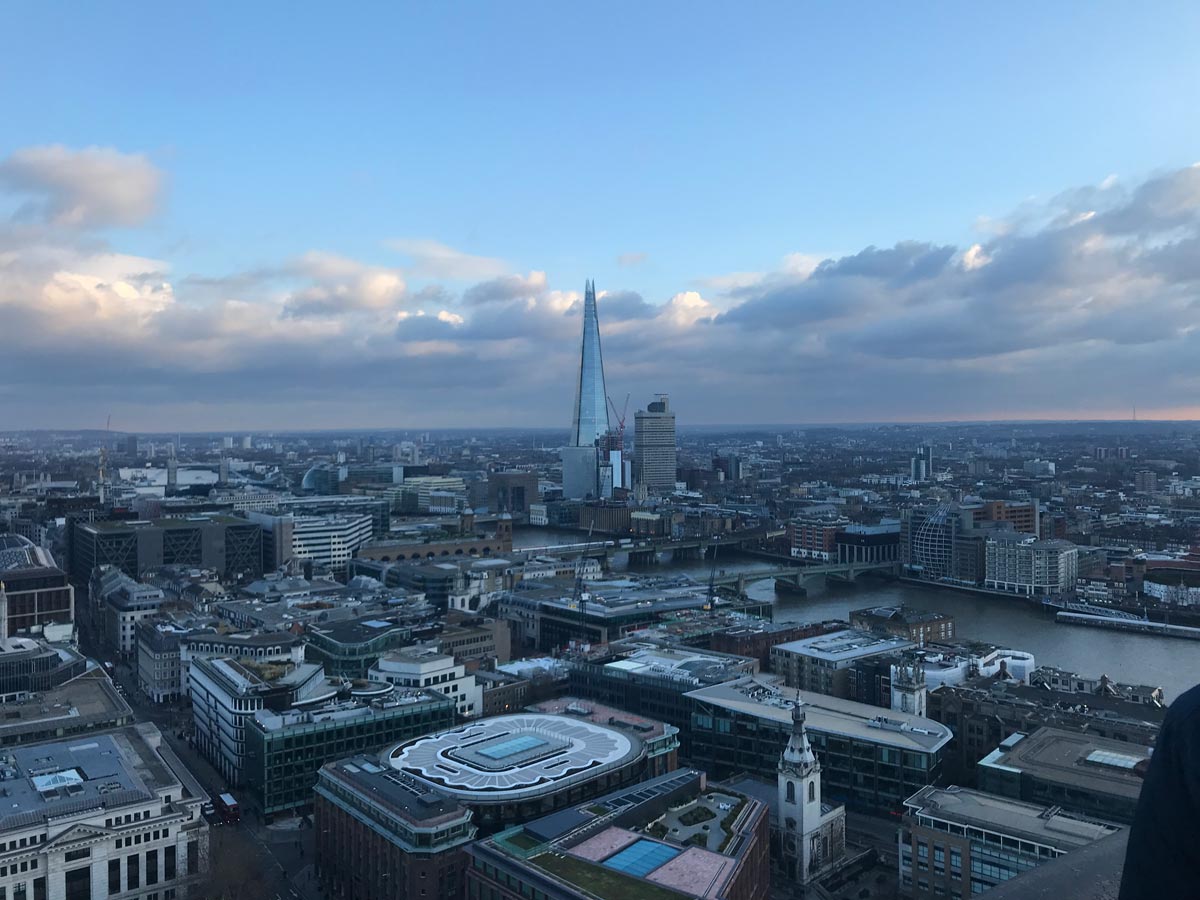 View from the top ; London’s iconic Shard building glistens in the distance
View from the top ; London’s iconic Shard building glistens in the distance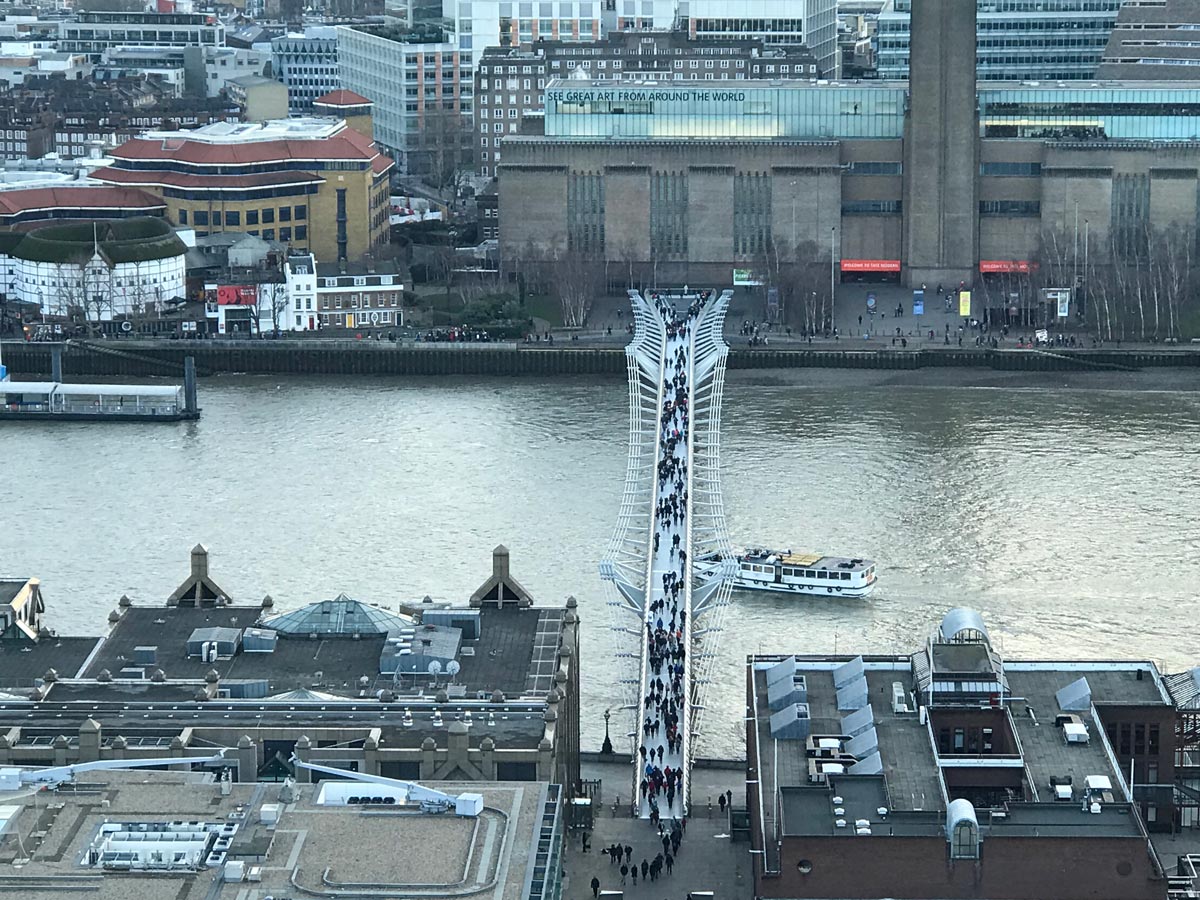 More Views from the top ; The Millennium Bridge teems with walkers
More Views from the top ; The Millennium Bridge teems with walkers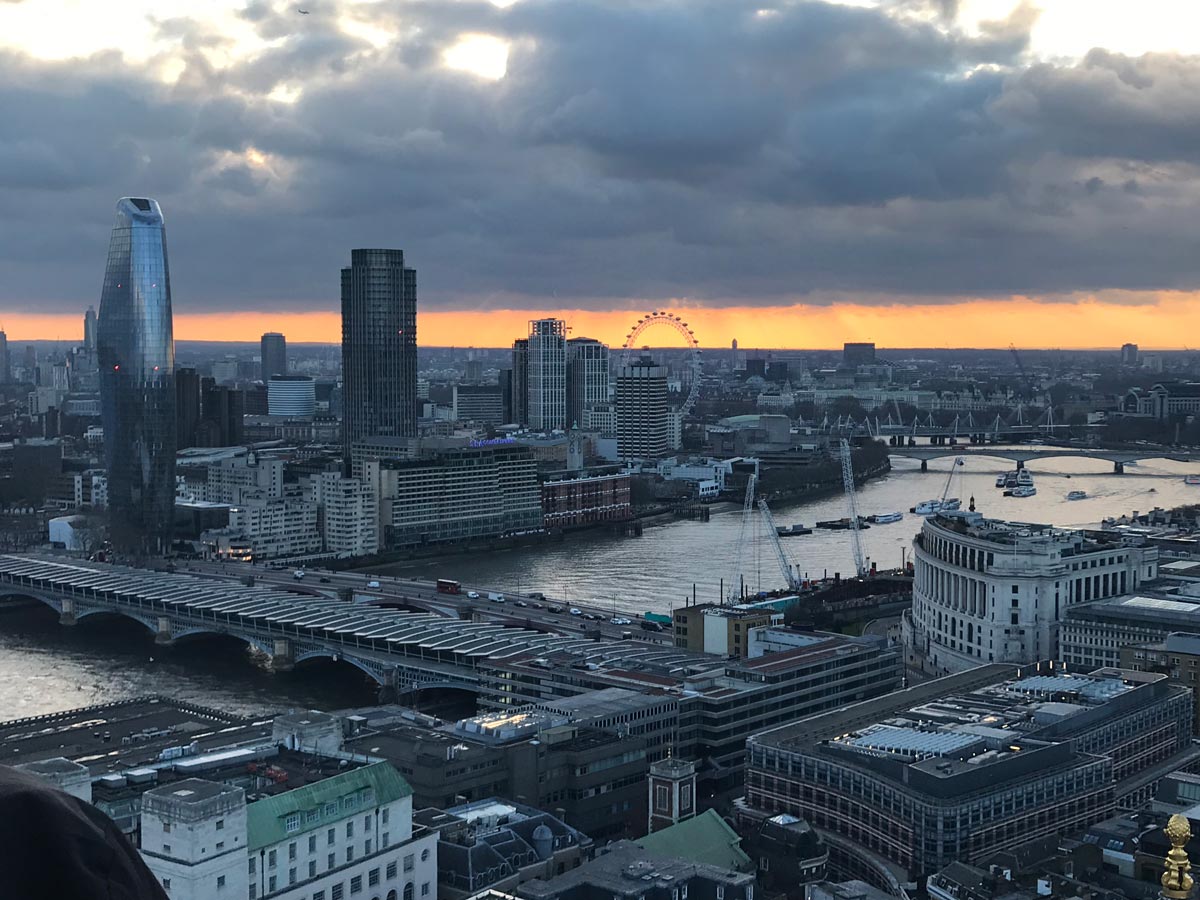 Yet More Views from the top ; sunset on the Thames with London Eye in the background
Yet More Views from the top ; sunset on the Thames with London Eye in the background
And finally, inexorably to the very top, squeezing through the last tiny staircase to the Golden Gallery. The Golden Gallery is not golden, but a very narrow stone walkaway around the highest part of the dome. It cannot hold too many people, and a staff member keeps the selfie-takers from lingering, moving them along. From here, I got an awe-inspiring three-sixty view of London and its attractions. The meandering Thames was below me, the Tower Bridge and Millennium Bridge, the iconic London Eye and steel arch of Wembley Stadium, and the fantastically shaped new additions to London’s skyline; buildings like “The Gherkin”, “The Cheese grater”, “The Shard”. I was on a high with a real sense of achievement, though admittedly with shaky nerves and shaky knees!
* “Edwin Lutyens, by his daughter Mary Lutyens”. Page 120
** “Edwin Lutyens, by his daughter Mary Lutyens”. Page 149
*** Edwin Lutyens, by his daughter Mary Lutyens”. Page 124
How to get here:
The closest London Tube station is St Pauls on the central line, from where it’s a two-minute walk to the Cathedral.
Information:
- Closest tube station : St Pauls on Central Line
- Open Monday to Saturday 8.30am-4.30pm
- Toilet facilities
- Wheelchair access
- Entry Ticket costs £20 per adult
- You should plan to spend about two hours at St Paul’s, specially of you want to climb to the top of the dome
Sources:
- “Indian Summer : Lutyens, Baker and Imperial Delhi”. By Robert Grant Irving. Published by Yale University Press, New Haven and London, 1981
- “Edwin Lutyens, by his daughter Mary Lutyens”. By Mary Lutyens. Published by Black Swan Books, London
- “Edwin Lutyens ; His Life, His Wife, His Work”. By Jane Ridley. Published by Pimlico, Random House, London, 2003
- “The life fo Sir Edwin Lutyens”. By Christopher Hussey. Published by Country Life Ltd, London
- “The Anarchy ; The East India Company, Corporate Violence, and the Pillage of an Empire. BY William Dalrymple. Published by Bloomsbury Publishing, 2019

